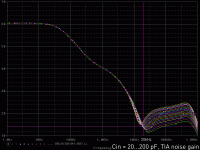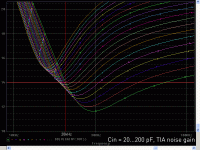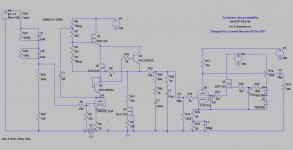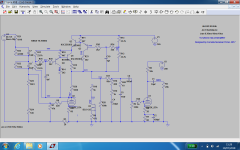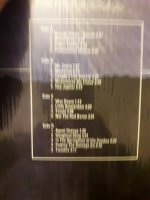Yes, this capacitor requires the right choice. As the simulation shows, when changing the cable capacitance from 20 to 200 pF, it is not required to change the value of C2. But when changing the value of R1 (which may be required to select the gain), it is required to change C2.Yes, I think the possible way of partially compensate this negative fenomena is to adjust NFB capacitor of first opamp (C2 || R1 in your circuit). But it is also adjustment for specific length and type of cable.
This is the reason why I made the first stage as a current-to-voltage converter without any frequency response correction. Initially, I wanted to compensate the L/R pole in the first stage (introduce the 1380 µs pole and the L/R zero). But since the L/R pole needs to be adjusted for different cartridges, the impedance of the feedback loop will change. I did not come up with a solution so that when adjusting it would be possible to manage with one value of C2.
Short translated citation from msg.#317 attach #3 of Jiri Dostal book:
"The typical capacitance of an input coaxial cable is 50-100 pF per meter of length. For broadband measurement of low currents, in order not to increase the noise background beyond the permissible value, it is necessary to place the amplifier as close as possible to the signal source and connect it with a short unshielded wire. This is a general principle applicable to any measurements carried out on the verge of physical and technical feasibility."
"The typical capacitance of an input coaxial cable is 50-100 pF per meter of length. For broadband measurement of low currents, in order not to increase the noise background beyond the permissible value, it is necessary to place the amplifier as close as possible to the signal source and connect it with a short unshielded wire. This is a general principle applicable to any measurements carried out on the verge of physical and technical feasibility."
This is the reason why I made the first stage as a current-to-voltage converter without any frequency response correction. Initially, I wanted to compensate the L/R pole in the first stage (introduce the 1380 µs pole and the L/R zero).
I think it would be nice circuitry if you organized a DС servo on the second op-amp, and did not add a third op-amp for this function.
In this case, results "on the verge of physical and technical feasibility" are not needed. Acceptable quality is also obtained using an interconnect cable. It is much more inconvenient to build an amplifier inside the player. Although in some cases this is acceptable and will certainly lead to a better result.it is necessary to place the amplifier as close as possible to the signal source and connect it with a short unshielded wire. This is a general principle applicable to any measurements carried out on the verge of physical and technical feasibility."
As far as noise growth at high frequencies, limiting the signal spectrum will be useful. On real vinyl discs above 16 - 20 kHz there is no useful signal (perhaps there are exceptions), but there is a lot of distortion. Passing these distortions further into the path is not entirely correct. When listening to vinyl, there should be no problems, although intermodulation distortion may occur in the amplifier and speakers. But when recording vinyl on a tape recorder, beats with a bias frequency in the audible range may occur. The same thing can happen when digitizing vinyl because the spectrum goes beyond the first Nyquist zone. Therefore, a steep filter with a cutoff frequency of about 20 kHz is desirable at the output of the phono stage, otherwise there is a risk of sound degradation.
I don't quite understand what is being proposed. Is it proposed to do all the frequency correction in the first stage? In my opinion, an elegant solution is to add a 1uF decoupling capacitor between the stages. So you can get a very simple transimpedance phono stage. A more complex version is also possible with a separate DC-servo circuit and additional output filters (low-pass filter, rumble filter, etc.).I think it would be nice circuitry if you organized a DС servo on the second op-amp, and did not add a third op-amp for this function.
I view it differently. once you know what the cause of a response curve is you know what to change to fix it. Good news is electrical performance is a simple roll off and you adjust the roll off to get the overall response you want. Few more weeks and will have some detailed data to present on the issue with some cartridges specifically built to have odd responses.this is an excellent conclusion in order not to worry about an increase (or decrease, as in TIA) of the load resistance of an MM cartridge relative to the "standard 47 kOhm", i.e. In what follows, we take into account only electrical resonance
It's illogical to decide to ignore the mechanical response because you can't damp it electrically. There are plenty of things you can do about it besides damping.What exactly? The moving system has a very weak connection with the coils and does not feel what is happening to them. For example, a short circuit of the coil of one channel does not affect the behavior of another in any way.
Of course if the mechanical response is fine, there is no need to do anything about it - but that is true with or without an electrical influence on the mechanical damping.
I understood what you meant. Of course, mechanical resonance must be taken into account. If necessary, you can make a special adjustment of the frequency response in the HF region. The available frequency response measurements using the test LP demonstrate good agreement with the "electrical" frequency response. It seems that for most cartridges the problem of mechanical resonance does not exist. More precisely, it will be possible to say from the results of measurements using a transimpedance amplifier, in which the "electrical" frequency response, taking into account the impedance of the cartridge, is linear at high frequencies. Such measurements were made on this forum with the Aurak amplifier.It's illogical to decide to ignore the mechanical response
The only problem there is that, unless you use a specific ortofon or AT cartridge all bets are off on that working.... More precisely, it will be possible to say from the results of measurements using a transimpedance amplifier, in which the "electrical" frequency response, taking into account the impedance of the cartridge, is linear at high frequencies. Such measurements were made on this forum with the Aurak amplifier.
Noise gain of the entire phono TIA at Cin = 20...200 pF.It is summing point capacitance (Cx) noise gain.
Attachments
If you are so much annoyed by impulse noise from scratches and dust on a record, then I recommend using an analog record click suppressor, developed by my friends from A.S.Bogatyrev`s Phonogram Restoration Laboratories (at Kyiv Research Institute of Electromechanical Devices). They radically improved the Burven declicker (KLH TNE-700) and were able to effectively suppress even the terrible crackle of shellac discs from the beginning of the last century (they restored the soundtracks of Caruso, Chaliapin, Lenin and others, for which they even received the State Prize of USSR). Well, it thrives on fine dust and scratches on LP, and it does it better than Adobe Audition or iZotope RX8 software declickers. Here you can listen [Few people are realistic about vinyl reproduction noise anyway..the vinyl itself won't be able to surpass even a 2 stage regular low noise (3dbNF)discrete bipolar input phono stage...I consider input noise the last problem you need touching when dealing with phono preamps.
Last edited:
I am not annoyed by the dust as much as I am annoyed by the fact that many designers don't recognize it as a real problem while we don't live and listen to music in a hyperbaric room...There are many declickers...some free, some for money...
By the way I'm going to purchess soon a professional Alessis compressor...but that's only for personal study as I'm not a musician.
For cheap phono reproduction I preffer either some minor SNR tradeoff for natural slew rate limiting of a low biased bipolar input stage where you get minimum voltage noise and acceptably good current noise , or low GM tubes that allow for lower gradient attack slope when sudden increase in input .Variable mu tubes are more natural at this making a good compressor , but few people tried them.
Actually we have a very toxic purist culture claiming best linear reproduction of vinyl that forgets that the anti-riaa+riaa system is a compander expander system much like NAB and Dolby...There's no real linearity with vinyl and never was so looking for the best possible response ignoring the real world is not helping anyone.
My first phono design in 2014 (unfortunately all the posted photos from 2014 were lost as they were tinypic links)
https://www.diyaudio.com/community/threads/unu-pnono-riaa-mm-preamp.255149/#post-5485527
reproduced perfect 25 khz squarewaves and visibly undistorted 480 khz sinewaves with no audible noise with D3A input tube, ultra low noise bipolar transistor mu-followers (gyrator) , it took me 1.5 years for research, design and final prototyping and while I have never heard a better sound from a phono preamp I never recommended it after 2015 to anyone to build such a thing because I found much simpler and cheaper solutions that allow for acceptably good sound.
I even had a second itteration in 2018
https://www.diyaudio.com/community/threads/1v2-phono-riaa-preamplifier.315824/#post-5269451
And again...never, not a single time after 2018 recommended it to anyone even though I was the only guy to implement a variable RIAA as EMT did and I did it before knowing EMT promoted a variable RIAA standard. Once I heard about EMT JPA 66 I stopped thinking I know anything
more than others on phono preamps.I'm 45...and the golden era of turntables already reached its highest possible peak in 1980.
In case you think my choices are due to some lack of resources I can tell that I have 90 x 2sk117 , 10x 2sk170 , 10x lm394, 20x original signetics, philips and early texas instruments ne5534an, countless njm2043, 2114, opa2228, njm2068s( 9 pin ground version) and many other ultralow noise bipolars and j fet op amps.
I'm only taking seriously the simplest technology and device that give me a good sound.
Way too many people start their topics with words like "ultimate", " best"...then promoting very complicated technologies or expensive components that can't compete with my 1990 Pioneer cassette decks...
By the way I'm going to purchess soon a professional Alessis compressor...but that's only for personal study as I'm not a musician.
For cheap phono reproduction I preffer either some minor SNR tradeoff for natural slew rate limiting of a low biased bipolar input stage where you get minimum voltage noise and acceptably good current noise , or low GM tubes that allow for lower gradient attack slope when sudden increase in input .Variable mu tubes are more natural at this making a good compressor , but few people tried them.
Actually we have a very toxic purist culture claiming best linear reproduction of vinyl that forgets that the anti-riaa+riaa system is a compander expander system much like NAB and Dolby...There's no real linearity with vinyl and never was so looking for the best possible response ignoring the real world is not helping anyone.
My first phono design in 2014 (unfortunately all the posted photos from 2014 were lost as they were tinypic links)
https://www.diyaudio.com/community/threads/unu-pnono-riaa-mm-preamp.255149/#post-5485527
reproduced perfect 25 khz squarewaves and visibly undistorted 480 khz sinewaves with no audible noise with D3A input tube, ultra low noise bipolar transistor mu-followers (gyrator) , it took me 1.5 years for research, design and final prototyping and while I have never heard a better sound from a phono preamp I never recommended it after 2015 to anyone to build such a thing because I found much simpler and cheaper solutions that allow for acceptably good sound.
I even had a second itteration in 2018
https://www.diyaudio.com/community/threads/1v2-phono-riaa-preamplifier.315824/#post-5269451
And again...never, not a single time after 2018 recommended it to anyone even though I was the only guy to implement a variable RIAA as EMT did and I did it before knowing EMT promoted a variable RIAA standard. Once I heard about EMT JPA 66 I stopped thinking I know anything
more than others on phono preamps.I'm 45...and the golden era of turntables already reached its highest possible peak in 1980.
In case you think my choices are due to some lack of resources I can tell that I have 90 x 2sk117 , 10x 2sk170 , 10x lm394, 20x original signetics, philips and early texas instruments ne5534an, countless njm2043, 2114, opa2228, njm2068s( 9 pin ground version) and many other ultralow noise bipolars and j fet op amps.
I'm only taking seriously the simplest technology and device that give me a good sound.
Way too many people start their topics with words like "ultimate", " best"...then promoting very complicated technologies or expensive components that can't compete with my 1990 Pioneer cassette decks...
Attachments
Last edited:
RIAA correction is (in principle, ignoring practical imperfections) just a cascade of two linear time-invariant filters, one on the recording and one on the playback side, that cancel each other. What has that got to do with a compander?
I may be the only one to use these terms so while it is a great chance of being an inappropriate or unfair use of terms I can't see a major difference btween the riaa equalization method and purpose and a compander-expande apart from the fact that it is fixed as levels and not dynamic in nature but they try to mitigate a known effect attached to the vinyl itself related to noises, hiss,
scratches, groove width...generally mechanical downsides of the recording medium
https://en.m.wikipedia.org/wiki/RIAA_equalization
https://en.m.wikipedia.org/wiki/Companding
Dbx has been called linear decibel companding and had fixed levels of action ...I might not be the only one in error 🙂
https://en.m.wikipedia.org/wiki/Dbx_(noise_reduction)
scratches, groove width...generally mechanical downsides of the recording medium
https://en.m.wikipedia.org/wiki/RIAA_equalization
https://en.m.wikipedia.org/wiki/Companding
Dbx has been called linear decibel companding and had fixed levels of action ...I might not be the only one in error 🙂
https://en.m.wikipedia.org/wiki/Dbx_(noise_reduction)
Frequency response pre-emphasis and companding are completely different things. Although the goal may be the same - increasing the signal-to-noise ratio.
Companding is level dependent..riaa equalization is frequency dependent but it's attached to groove width control and while completely independent processes, they affect each other as total outcome and are bought together in a vinyl record and ser e same purpose.So yes, they are completely different things but a vinyl recording encoding decoding process is also level dependent .
No.vinyl recording encoding decoding process is also level dependent .
Not outright, but it helps the riaa decoding final outcome.Some of the intricacies are best discussed here:
https://www.lathetrolls.com/
I started to be interested in this aspect after buying a Tory Amos album that was a hellish task to read made my turntable setup(Dual 701 and Shure v15type3 with a 70 bucks stylus) an almost impossible task.There's also the Daft Punk RAM album that took me ages to have a good listen to, especially Motherboard track.Buy this damn album and you'll be introduced to probably the most difficult album to read and listen:
https://www.lathetrolls.com/
I started to be interested in this aspect after buying a Tory Amos album that was a hellish task to read made my turntable setup(Dual 701 and Shure v15type3 with a 70 bucks stylus) an almost impossible task.There's also the Daft Punk RAM album that took me ages to have a good listen to, especially Motherboard track.Buy this damn album and you'll be introduced to probably the most difficult album to read and listen:
Attachments
Last edited:
This is not companding but called mastering. LP needs special mastering. it is true.
But 192/24 digital may be even more musical - hear my remaster of Radio Ga-Ga and tell is my better than Queen original? - https://www.patreon.com/posts/dlia-igoria-moi-59538923
- Home
- Vendor's Bazaar
- Nick Sukhov SU-XXI MM Phono stage -85 dBA SN ratio...
